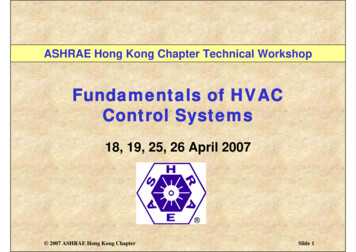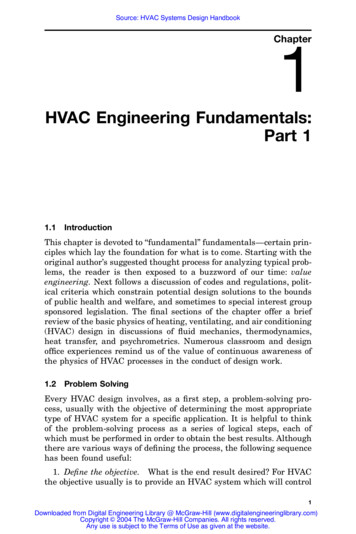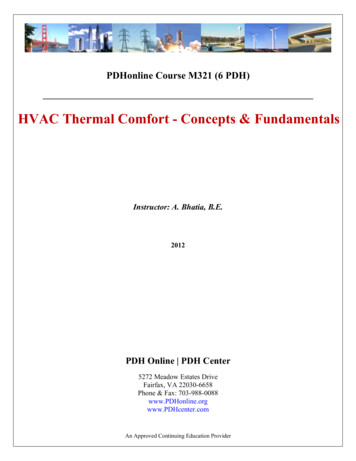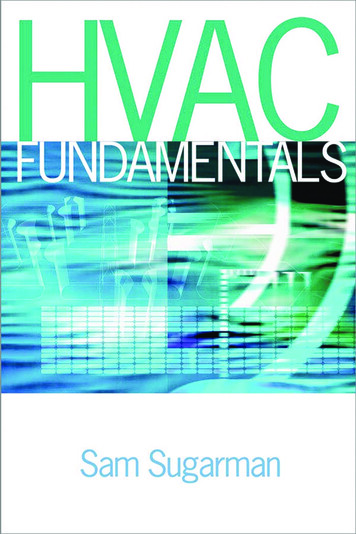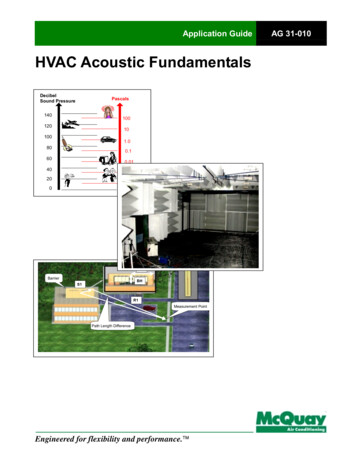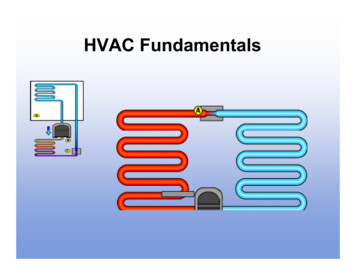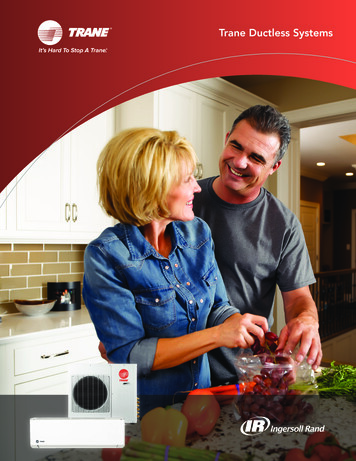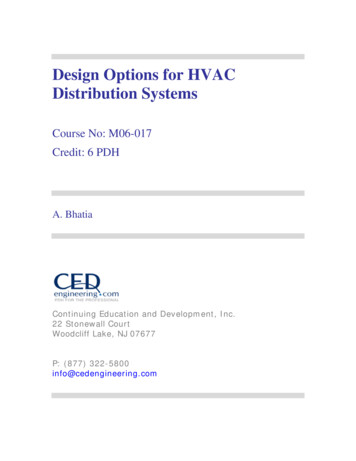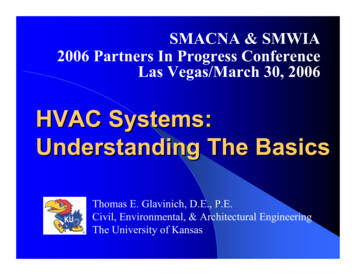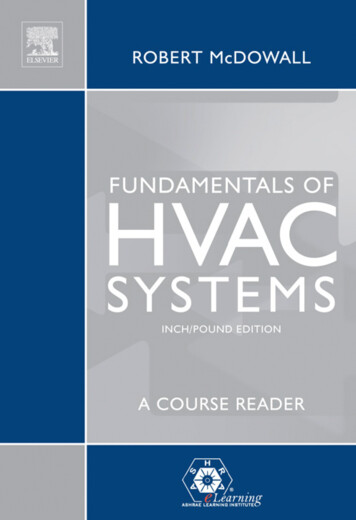
Transcription
Fundamentals of HVAC Systems
This Page is Intentionally Left Blank
Fundamentals of HVAC SystemsPrepared byRobert McDowall, P. Eng.Engineering Change Inc.American Society of Heating, Refrigerating andAir-Conditioning Engineers Inc.1791 Tullie Circle NE, Atlanta, GA 30329, USAAMSTERDAM BOSTON HEIDELBERG LONDONNEW YORK OXFORDPARIS SAN DIEGOSAN FRANCISCO SINGAPORE SYDNEY TOKYOButterworth-Heinemann is an imprint of Elsevier
Butterworth-Heinemann is an imprint of ElsevierLinacre House, Jordan Hill, Oxford OX2 8DP, UKThe Boulevard, Langford Lane, Kidlington, Oxford OX5 1GB, UK84 Theobald’s Road, London WC1X 8RR, UKRadarweg 29, PO Box 211, 1000 AE Amsterdam, The Netherlands30 Corporate Drive, Suite 400, Burlington, MA 01803, USA525 B Street, Suite 1900, San Diego, CA 92101-4495, USAFirst edition 2006Copyright 2006, American Society of Heating, Refrigerating and Air-ConditioningEngineers, Inc. and Elsevier Inc Published by Elsevier 2006. All rights reservedThe right of American Society of Heating, Refrigerating and Air-ConditioningEngineers, Inc. and Elsevier Inc to be identified as the author of this work has beenasserted in accordance with the Copyright, Designs and Patents Act 1988No part of this publication may be reproduced, stored in a retrieval systemor transmitted in any form or by any means electronic, mechanical, photocopying,recording or otherwise without the prior written permission of the publisherPermissions may be sought directly from Elsevier’s Science & Technology RightsDepartment in Oxford, UK: phone ( 44) (0) 1865 843830; fax ( 44) (0) 1865 853333;email: permissions@elsevier.com. Alternatively you can submit your request online byvisiting the Elsevier web site at http://elsevier.com/locate/permissions, and selectingObtaining Permission to use Elsevier materialNoticeNo responsibility is assumed by the publisher for any injury and/or damage to personsor property as a matter of products liability, negligence or otherwise, or from any useor operation of any methods, products, instructions or ideas contained in the materialherein. Because of rapid advances in the medical sciences, in particular, independentverification of diagnoses and drug dosages should be madeBritish Library Cataloguing in Publication DataA catalogue record for this book is available from the British LibraryLibrary of Congress Cataloging-in-Publication DataA catalog record for this book is available from the Library of CongressISBN–13: 978-0-12-372497-7ISBN–10: 0-12-372497-XFor information on all Butterworth-Heinemann publicationsvisit our web site at books.elsevier.comPrinted and bound in Great Briatin060708091010987654321Working together to growlibraries in developing countrieswww.elsevier.com www.bookaid.org www.sabre.org
ContentsForeword123ixIntroduction to HVAC1Study Objectives of Chapter 11.1 Introduction1.2 Brief History of HVAC1.3 Scope of Modern HVAC1.4 Introduction to Air-conditioning Processes1.5 Objective: What is your system to achieve?1.6 Environment For Human ComfortThe Next StepSummaryBibliography1123346889Introduction to HVAC Systems10Study Objectives of Chapter 22.1 Introduction2.2 Introducing the Psychrometric Chart2.3 Basic Air-Conditioning System2.4 Zoned Air-Conditioning Systems2.5 Choosing an Air-Conditioning System2.6 System Choice MatrixThe Next StepSummaryBibliography10101120232628303031Thermal Comfort32Study Objectives of Chapter 33.1 Introduction: What is Thermal Comfort?3.2 Seven Factors Influencing Thermal Comfort3.3 Conditions for Comfort3.4 Managing Under Less Than Ideal Conditions3.5 Requirements of Non-Standard GroupsThe Next StepSummaryBibliography323233363940414142
vi4567ContentsVentilation and Indoor Air Quality43Study Objectives of Chapter 44.1 Introduction4.2 Air Pollutants and Contaminants4.3 Indoor Air Quality Effects on Health and Comfort4.4 Controlling Indoor Air Quality4.5 ASHRAE Standard 62 Ventilation for Acceptable IndoorAir QualityThe Next udy Objectives of Chapter 55.1 Introduction5.2 What is a Zone?5.3 Zoning Design5.4 Controlling the ZoneThe Next StepSummary60606162656767Single Zone Air Handlers and Unitary Equipment68Study Objectives of Chapter 66.1 Introduction6.2 Examples of Buildings with Single-zone PackageAir-Conditioning Units6.3 Air-Handling Unit Components6.4 Refrigeration Equipment6.5 System Performance Requirements6.6 Rooftop Units6.7 Split SystemsThe Next ple Zone Air Systems88Study Objectives of Chapter 77.1 Introduction7.2 Single-Duct, Zoned Reheat, Constant Volume Systems7.3 Single-Duct, Variable Air Volume Systems7.4 By-Pass Box Systems7.5 Constant Volume Dual-Duct, All-Air Systems7.6 Multizone Systems7.7 Three-deck Multizone Systems7.8 Dual-Duct, Variable Air Volume Systems7.9 Dual Path Outside Air SystemsThe Next StepSummary888890929495989999100101101
Contents891011viiHydronic Systems103Study Objectives of Chapter 88.1 Introduction8.2 Natural Convection and Low Temperature RadiationHeating Systems8.3 Panel Heating and Cooling8.4 Fan Coils8.5 Two Pipe Induction Systems8.6 Water Source Heat PumpsThe Next 116Hydronic System Architecture117Study Objectives of Chapter 99.1 Introduction9.2 Steam9.3 Water Systems9.4 Hot Water9.5 Chilled Water9.6 Condenser WaterThe Next 132Central Plants133Study Objectives of Chapter 1010.1 Introduction10.2 Central Plant Versus Local Plant in a Building10.3 Boilers10.4 Chillers10.5 Cooling TowersThe Next Controls148Study Objectives of Chapter 1111.1 Introduction11.2 Basic Control11.3 Typical Control loops11.4 Introduction to Direct Digital Control, DDC11.5 Direct Digital Control of an Air-Handler11.6 Architecture and Advantages of Direct Digital ControlsThe Next 170
viii1213ContentsEnergy Conservation Measures171Study Objectives of Chapter 1212.1 Introduction12.2 Energy Considerations for Buildings12.3 ASHRAE/IESNA Standard 90.112.4 Heat Recovery12.5 Air-Side and Water-Side Economizers12.6 Evaporative Cooling12.7 Control of Building PressureThe Final 187189Special Applications190Study Objectives of Chapter 1313.1 Introduction13.2 Radiant Heating and Cooling Systems13.3 Thermal Storage Systems13.4 The Ground as Heat Source and Sink13.5 Occupant Controlled Windows with HVAC13.6 Room Air Distribution Systems13.7 Decoupled or Dual Path, and Dedicated OutdoorAir SystemsSummaryYour Next 5216219
ForewordWelcome to the ASHRAE Learning Institute’s Fundamentals of HVAC&ReLearning System series.This is the Course Reader to accompany the Fundamentals of HVACSystems online modules. To help you learn at your convenience, this CourseReader is also available to you as an eBook included with the online CourseModules.The Course Reader will provide you with background information to helpyou develop in-depth knowledge of the Fundamentals of HVAC Systems, toimprove your skills in HVAC&R and to earn the 35 PDHs/3.5 CEUs awardedfor successful completion of the Fundamentals of HVAC Systems Learningcourse.We look forward to working with you and helping you achieve maximumresults from the course.
This Page is Intentionally Left Blank
Chapter 1Introduction to HVACContents of Chapter 1Study Objectives of Chapter 11.1 Introduction1.2 History of HVAC1.3 Scope of Modern HVAC1.4 Introduction To Air-Conditioning Processes1.5 Objective: what is your system to achieve?1.6 Environment For Human ComfortThe Next StepSummaryBibliographyStudy Objectives of Chapter 1Chapter 1 introduces the history, uses and main processes of heating, ventilating and air conditioning. There are no calculations to be done. The ideas willbe addressed in detail in later chapters. After studying the chapter, you shouldbe able to:Define heating, ventilating and air conditioning.Describe the purposes of heating, ventilating and air conditioning.Name and describe seven major air-conditioning processes.Identify five main aspects of a space that influence an occupant’s comfort.1.1 IntroductionHeating, Ventilating and Air Conditioning, HVAC, is a huge field. HVAC systems include a range from the simplest hand-stoked stove, used for comfortheating, to the extremely reliable total air-conditioning systems found in submarines and space shuttles. Cooling equipment varies from the small domesticunit to refrigeration machines that are 10,000 times the size, which are used inindustrial processes.Depending on the complexity of the requirements, the HVAC designer mustconsider many more issues than simply keeping temperatures comfortable.This chapter will introduce you to the fundamental concepts that are used bydesigners to make decisions about system design, operation, and maintenance.
2Fundamentals of HVAC1.2 Brief History of HVACFor millennia, people have used fire for heating. Initially, the air required tokeep the fire going ensured adequate ventilation for the occupants. However,as central furnaces with piped steam or hot water became available for heating, the need for separate ventilation became apparent. By the late 1880s, rulesof thumb for ventilation design were developed and used in many countries.In 1851 Dr. John Gorrie was granted U.S. patent 8080 for a refrigerationmachine. By the 1880s, refrigeration became available for industrial purposes.Initially, the two main uses were freezing meat for transport and making ice.However, in the early 1900s there was a new initiative to keep buildings coolfor comfort. Cooling the New York Stock Exchange, in 1902, was one of thefirst comfort cooling systems. Comfort cooling was called “air conditioning.”Our title, “HVAC,” thus captures the development of our industry. The term“air conditioning” has gradually changed, from meaning just cooling, to thetotal control of: TemperatureMoisture in the air (humidity)Supply of outside air for ventilationFiltration of airborne particlesAir movement in the occupied spaceThroughout the rest of this text we will use the term “air conditioning” toinclude all of these issues and continue to use “HVAC” where only some ofthe elements of full air conditioning are being controlled.To study the historical record of HVAC is to take a fascinating trip through thetremendous technical and scientific record of society. There are the pioneers suchas Robert Boyle, Sadi Carnot, John Dalton, James Watt, Benjamin Franklin, JohnGorrie, Lord Kelvin, Ferdinand Carré, Willis Carrier and Thomas Midgley, alongwith many others, who have brought us to our current state. Air-conditioningtechnology has developed since 1900 through the joint accomplishments of science and engineering. Advances in thermodynamics, fluid mechanics, electricity,electronics, construction, materials, medicine, controls and social behavior are thebuilding blocks to better engineered products of air conditioning.Historical accounts are not required as part of this course but, for theenjoyment and perspective it provides, it is worth reading an article such as“Milestones in Air Conditioning,” by Walter A. Grant1 or the book about WillisCarrier, The Father of Air Conditioning.2 The textbook Principles of Heating,Ventilating, and Air Conditioning,3 starts with a concise and comprehensive history of the HVAC industry.HVAC evolved based on: Technological discoveries, such as refrigeration, that were quickly adoptedfor food storage.Economic pressures, such as the reduction in ventilation rates after the 1973energy crisis.Computerization and networking, used for sophisticated control of largecomplex systems serving numerous buildings.Medical discoveries, such as the effects of second hand smoke on people,which influenced ventilation methods.
Introduction to HVAC31.3 Scope of Modern HVACModern air conditioning is critical to almost every facet of advancing humanactivity. Although there have been great advances in HVAC, there are severalareas where active research and debate continue.Indoor air quality is one that directly affects us. In many countries ofthe world there is a rapid rise in asthmatics and increasing dissatisfactionwith indoor-air-quality in buildings and planes. The causes and effects areextremely complex. A significant scientific and engineering field has developed to investigate and address these issues.Greenhouse gas emissions and the destruction of the earth’s protective ozonelayer are concerns that are stimulating research. New legislation and guidelines are evolving that encourage: recycling; the use of new forms of energy;less energy usage; and low polluting materials, particularly refrigerants. Allthese issues have a significant impact on building design, including HVACsystems and the design codes.Energy conservation is an ongoing challenge to find novel ways to reduceconsumption in new and existing buildings without compromising comfortand indoor air quality. Energy conservation requires significant cooperationbetween disciplines.For example, electric lighting produces heat. When a system is in a coolingmode, this heat is an additional cooling load. Conversely, when the system isin a heating mode, the lighting heat reduces the load on the building heatingsystem. This interaction between lighting and HVAC is the reason thatASHRAE and the Illuminating Engineering Society of North America (IESNA)joined forces to write the building energy conservation standard, Standard90.1–2004, Energy Standard for Buildings Except Low-Rise Residential Buildings4.1.4 Introduction to Air-conditioning ProcessesAs mentioned earlier, the term “air conditioning,” when properly used, nowmeans the total control of temperature, moisture in the air (humidity), supplyof outside air for ventilation, filtration of airborne particles,
Fundamentals of HVAC Systems Prepared by Robert McDowall, P. Eng. Engineering Change Inc. American Society of Heating, Refrigerating and Air-Conditioning Engineers Inc. 1791 Tullie Circle NE, Atlanta, GA 30329, USA AMSTERDAM BOSTON HEIDELBERG LONDON NEW YORK OXFORDPARIS SAN DIEGO SAN FRANCISCO SINGAPORE SYDNEY TOKYO Butterworth

